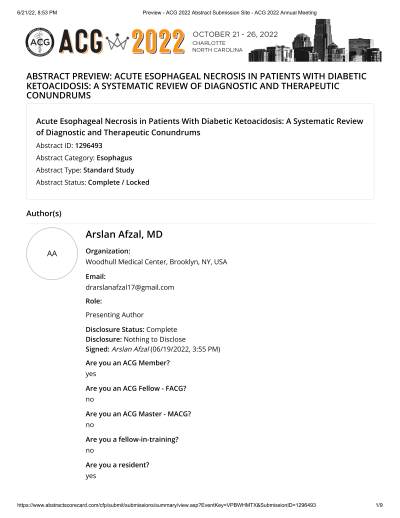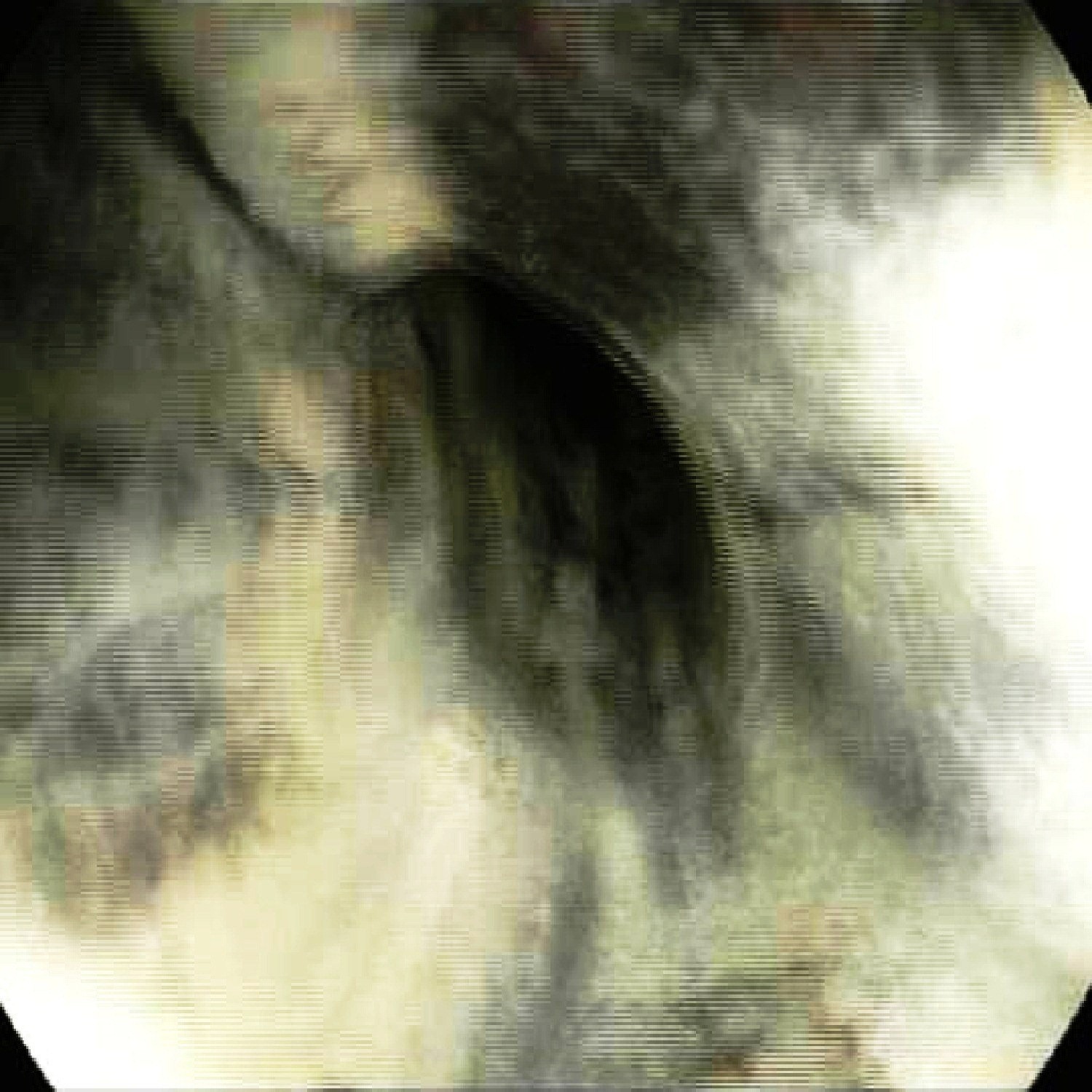Back


Poster Session D - Tuesday Morning
Category: Esophagus
D0199 - Acute Esophageal Necrosis in Patients With Diabetic Ketoacidosis: A Systematic Review of Diagnostic and Therapeutic Conundrums
Tuesday, October 25, 2022
10:00 AM – 12:00 PM ET
Location: Crown Ballroom

Has Audio
- AA
Arslan Afzal, MD
Woodhull Medical Center
Brooklyn, NY
Presenting Author(s)
Arslan Afzal, MD1, Faisal Inayat, MBBS2, Hafiz Muhammad Kashif Saleem, MBBS2, Marjan Haider, MD3, Muhammad Hassan Naeem Goraya, MBBS4, Faisal Ibrahim, MBBS5
1Woodhull Medical Center, Brooklyn, NY; 2Allama Iqbal Medical College, Lahore, Punjab, Pakistan; 3St. Joseph Mercy Hospital, Ypsilanti, MI; 4Allama Iqbal Medical College, Lahoe, Punjab, Pakistan; 5Wexham Park Hospital, Slough, England, United Kingdom
Introduction: Acute esophageal necrosis (AEN) associated with diabetic ketoacidosis (DKA) remains an exceedingly rare clinical entity. The likely causal mechanism is related to hypoperfusion and transient hyperglycemic gastric dysmotility, potentially increasing the risk of AEN. To our knowledge, this is the first systematic review of AEN in patients with DKA.
Methods: A systematic search of MEDLINE, Embase, Scopus, and Cochrane was conducted for English-only articles published between inception and June 15, 2022. Abstracts from major gastroenterology conferences and bibliography lists were also reviewed. Search terms "esophageal necrosis" and "black esophagus" were combined using the Boolean operators ‘AND’ and ‘OR’ with the terms "diabetic ketoacidosis" and "diabetes mellitus," with all permutations. Two authors independently reviewed each article for eligibility. The search yielded a total of 326 results. However, 28 articles fulfilled the inclusion criteria.
Results: A total of 31 case reports only (clinical evidence level: IV) of AEN in the setting of DKA were included, dating from 2014 to 2022. The mean age of patients was 52.81 ± 13.49 years (range: 30–78 years) and 61% of cases were reported in males. Common presenting symptoms were hematemesis (58%), nausea (55%), abdominal pain (53%), vomiting (35%), and altered mental status (19%). Apart from diabetes, major comorbidities were hypertension (29%), alcoholism (23%), GERD (16%), and COPD (10%). On EGD, 58% had pan-esophageal, 26% had mid-to-distal, and 16% of patients had distal segment disease. Esophageal biopsy was documented in 29% of patients. All patients received insulin and fluid replacement therapies. PPIs in 60%, sucralfate in 32%, antifungals in 29%, and antibiotics were administered in 19% of patients. Blood transfusions were performed in 16% of patients. The mortality rate was 6.4%. AEN complications included esophageal stenosis (6%), as well as stricture formation (6%).
Discussion: This systematic review reiterates the occurrence of AEN in association with DKA. Overt GI bleeding is a common presentation, but patients may develop nausea, abdominal pain, vomiting, and disorientation as major symptoms. Therefore, endoscopists should keep a low threshold for performing EGD in DKA patients. While the cause-and-effect relation of AEN with hyperglycemia are unclear, fluid replacement and gastric acid suppression are pertinent to the management of AEN.

Disclosures:
Arslan Afzal, MD1, Faisal Inayat, MBBS2, Hafiz Muhammad Kashif Saleem, MBBS2, Marjan Haider, MD3, Muhammad Hassan Naeem Goraya, MBBS4, Faisal Ibrahim, MBBS5. D0199 - Acute Esophageal Necrosis in Patients With Diabetic Ketoacidosis: A Systematic Review of Diagnostic and Therapeutic Conundrums, ACG 2022 Annual Scientific Meeting Abstracts. Charlotte, NC: American College of Gastroenterology.
1Woodhull Medical Center, Brooklyn, NY; 2Allama Iqbal Medical College, Lahore, Punjab, Pakistan; 3St. Joseph Mercy Hospital, Ypsilanti, MI; 4Allama Iqbal Medical College, Lahoe, Punjab, Pakistan; 5Wexham Park Hospital, Slough, England, United Kingdom
Introduction: Acute esophageal necrosis (AEN) associated with diabetic ketoacidosis (DKA) remains an exceedingly rare clinical entity. The likely causal mechanism is related to hypoperfusion and transient hyperglycemic gastric dysmotility, potentially increasing the risk of AEN. To our knowledge, this is the first systematic review of AEN in patients with DKA.
Methods: A systematic search of MEDLINE, Embase, Scopus, and Cochrane was conducted for English-only articles published between inception and June 15, 2022. Abstracts from major gastroenterology conferences and bibliography lists were also reviewed. Search terms "esophageal necrosis" and "black esophagus" were combined using the Boolean operators ‘AND’ and ‘OR’ with the terms "diabetic ketoacidosis" and "diabetes mellitus," with all permutations. Two authors independently reviewed each article for eligibility. The search yielded a total of 326 results. However, 28 articles fulfilled the inclusion criteria.
Results: A total of 31 case reports only (clinical evidence level: IV) of AEN in the setting of DKA were included, dating from 2014 to 2022. The mean age of patients was 52.81 ± 13.49 years (range: 30–78 years) and 61% of cases were reported in males. Common presenting symptoms were hematemesis (58%), nausea (55%), abdominal pain (53%), vomiting (35%), and altered mental status (19%). Apart from diabetes, major comorbidities were hypertension (29%), alcoholism (23%), GERD (16%), and COPD (10%). On EGD, 58% had pan-esophageal, 26% had mid-to-distal, and 16% of patients had distal segment disease. Esophageal biopsy was documented in 29% of patients. All patients received insulin and fluid replacement therapies. PPIs in 60%, sucralfate in 32%, antifungals in 29%, and antibiotics were administered in 19% of patients. Blood transfusions were performed in 16% of patients. The mortality rate was 6.4%. AEN complications included esophageal stenosis (6%), as well as stricture formation (6%).
Discussion: This systematic review reiterates the occurrence of AEN in association with DKA. Overt GI bleeding is a common presentation, but patients may develop nausea, abdominal pain, vomiting, and disorientation as major symptoms. Therefore, endoscopists should keep a low threshold for performing EGD in DKA patients. While the cause-and-effect relation of AEN with hyperglycemia are unclear, fluid replacement and gastric acid suppression are pertinent to the management of AEN.

Figure: Upper endoscopy showing necrotic-appearing black esophagus in the lower third of esophagus in a female diabetic patient .
Disclosures:
Arslan Afzal indicated no relevant financial relationships.
Faisal Inayat indicated no relevant financial relationships.
Hafiz Muhammad Kashif Saleem indicated no relevant financial relationships.
Marjan Haider indicated no relevant financial relationships.
Muhammad Hassan Naeem Goraya indicated no relevant financial relationships.
Faisal Ibrahim indicated no relevant financial relationships.
Arslan Afzal, MD1, Faisal Inayat, MBBS2, Hafiz Muhammad Kashif Saleem, MBBS2, Marjan Haider, MD3, Muhammad Hassan Naeem Goraya, MBBS4, Faisal Ibrahim, MBBS5. D0199 - Acute Esophageal Necrosis in Patients With Diabetic Ketoacidosis: A Systematic Review of Diagnostic and Therapeutic Conundrums, ACG 2022 Annual Scientific Meeting Abstracts. Charlotte, NC: American College of Gastroenterology.
